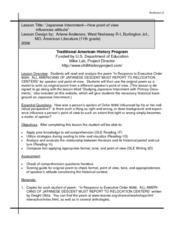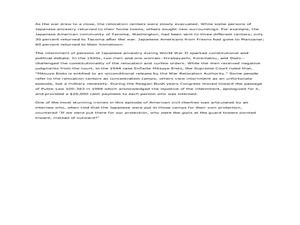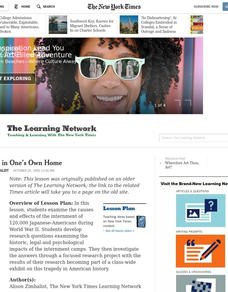Curated OER
Japanese Internment--How Point of View Influences Attitude
How does background and experience influence one's point of view? Dwight Okita's famous poem about the Japanese internment is the text used to explore this essential question. Class members study primary documents to gain the necessary...
Center for History Education
Japanese American Internment During World War II
World War II turned nations against each other and neighbors into enemies. An eye-opening lesson explores the dark past of Japanese-American internment camps during WWII. Scholars learn of the fear and distrust toward Asian Americans...
UNICEF
Refugees and IDPs Activities
Class members have an opportunity to consider issues faced by refugees and Internally Displaced Persons (IDPs) by participating in a series of activities that illustrate some of the challenges refugees experience.
Curated OER
Setting Up Camp
Draw on what learners know about conflict resolution and the situation in the Middle East to build understanding of the Camp David summit meeting beginning on July 11, 2000. They develop an understanding of the functions of summit...
Smithsonian Institution
Who's in Camp?
Pupils complete readings, a group activity using cards, and a writing activity to better understand people's lives during the American Revolution. The resource emphasizes people such as the militiamen, women, officers, and children,...
American Battlefield Trust
Contraband Camp
An educational lesson plan explores the plight of African Americans escaping slavery during the Civil War. Learners view a presentation and analyze primary documents and images to understand the purpose of contraband camps and how they...
Curated OER
Japanese-American Internment--Constitutional or Unconstitutional
Explore what the home front during WWII was like for Japanese-Americans. Learners use a worksheet and the Internet to guide their research as they consider the constitutionality of Japanese Internment. They work in pairs to create an...
Curated OER
Changing Perspectives on the Japanese Internment Experience
Students explore the issue of Japanese-American internment. In this World War II activity, students analyze historical biases regarding Japanese-American internment as they analyze literature, research print and Internet sources, and...
Curated OER
Japanese American Internment
Students create a presentation based on the primary sources they have researched about the Japanese Americans that were held in internment camps during World War II. In this Japanese Americans lesson plan, students read different points...
Student Achievement Partners
Laura Hillenbrand's "Unbroken" and Jeanne Wakatsuki Houston and James D. Houston's "Farewell to Manzanar"
Passages from Unbroken and Farewell to Manzanar provide the context for a study of the historical themes of experiencing war, resilience during war, and understanding the lasting trauma of war. Appendices include extension activities,...
Goethe-Institut
Life in a Refugee Camp
To raise awareness of the complexity of the immigration debate, class groups examine facts about one aspect of life in a refugee camp and then, in a jigsaw activity, share what they have learned with their new group. Groups then prepare...
Curated OER
The Holocaust: Concentration Camps
Tenth graders, after reading a variety of passages and watching a video on "Children Remember the Holocaust," explore the concept of brutality of deportation and analyze conditions in concentration and death camps. They review maps and...
Curated OER
Life and Death in the Camps
Students state the difference between death camps and concentration camps used during the Holocaust. Using primary source documents, they summarize what life in the camp was like. They describe the final solution used by the Nazis.
Curated OER
Japanese-American Internment: The Art of Gaman
Students explore Japanese-American internment. For this World War II lesson, students view a PowerPoint lecture that features the art of Gaman and determine what the art reveals about the experiences of the interned Japanese-Americans.
Curated OER
Japanese Internment
Fourth graders practice their writing skills. In this reading comprehension lesson plan, 4th graders review baseball terminology and then read Baseball Saved Us. In this story students learn about Japanese Americans that were taken...
Curated OER
Introduction to Japanese Internment
Young scholars discover details about Japanese Internment. In this World War II instructional activity, students analyze images and documents related to the movement of Japanese-Americans to West coast internment camps in the wake of the...
Curated OER
Active Viewing: Abraham and Mary Lincoln: A House Divided
Young historians consider the cause and effects of the Emancipation Proclamation. They use handouts, response sheets, and class discussion to build an opinion about the subject after viewing the PBS documentary Abraham and Mary Lincoln:...
Curated OER
Japanese-American Relocation
Consider the causes and effects that led to the internment and relocation of Japanese Americans during WWII. Learners read the story "Baseball Saved Us" and selected chapters from Farewell to Manzanar. Then, they view a slide-show, and...
Curated OER
Prisoner in One's Own Home
Examine the internment of Japanese-Americans during World War II. After reading an article from the New York Times and exploring the author's word choice, young readers find the central idea in the text and work on researching additional...
Curated OER
World War II Home Front
Eleventh graders examine the political demands put on one of four groups living in America during WWII. Each class member is asked to research and write a paper describing the homefront experience for women, Hispanics, African-Americans,...
Echoes & Reflections
Survivors and Liberators
The end was just the beginning. The period immediately after the end of World War II and the Holocaust is often called "The Return to Life" as survivors looked to reunite and recreate broken families and shattered lives. A two-lesson...
Echoes & Reflections
The "Final Solution"
Nazi policies shifted from deportation and imprisonment to extermination of the Jewish people in death camps in the "Final Solution." Learners examine photos of artifacts, read poetry written by survivors, analyze testimony from...
Echoes & Reflections
Jewish Resistance
Resistance to the Holocaust took on many forms. Learners explore the passive and active resistance of Jewish people who continued their practices and observances, as well as organized resistance against the evils of the Nazis. An...
Echoes & Reflections
Rescuers and Non-Jewish Resistance
What does it mean to be a rescuer during the time of the Holocaust? Learners consider the role of those who resisted the Nazi invasions, including hiding Jewish people, throughout Europe. Activities include listening to the testimony of...

























